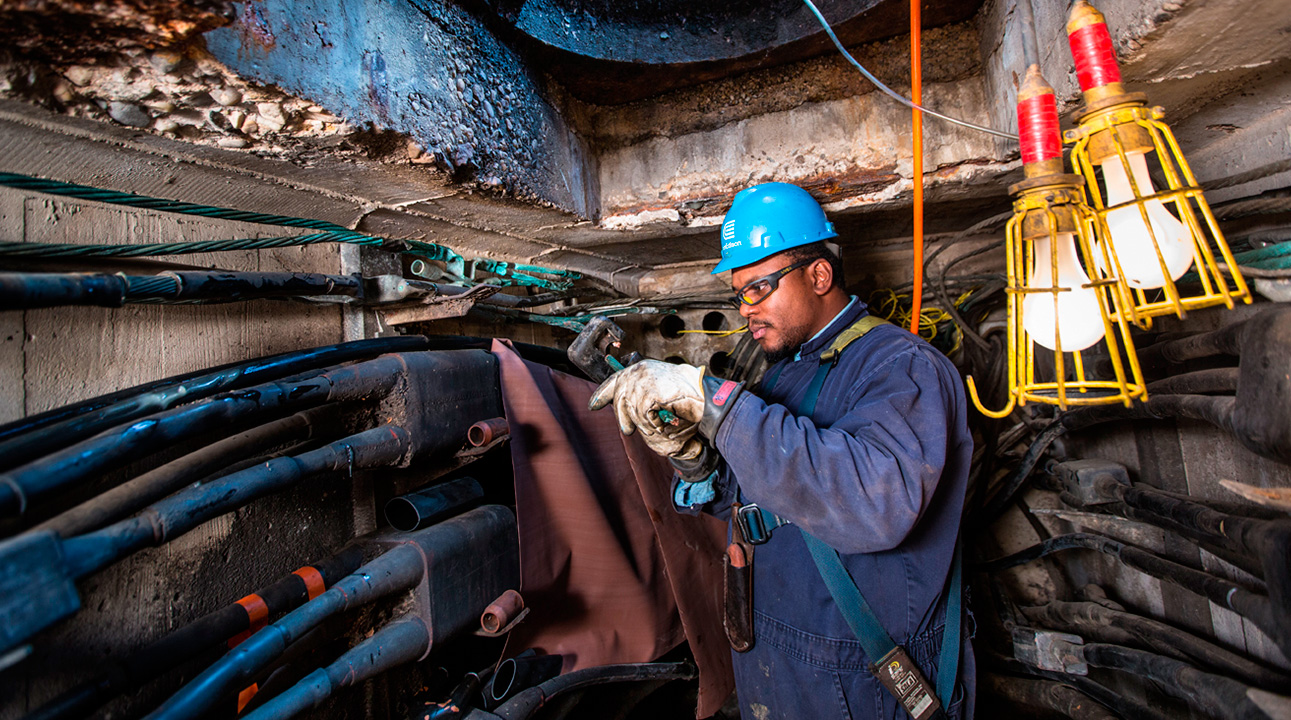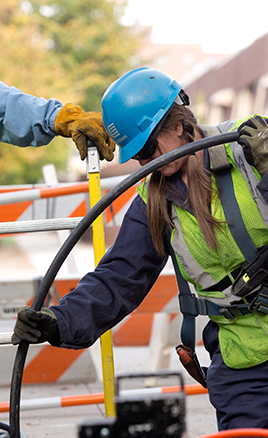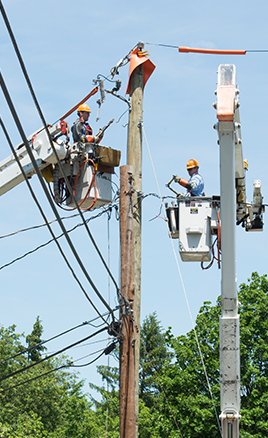
 At Con Edison, Zero Harm is our commitment to realizing injury-free work performance and getting the job done without harm to the public, our contractors, or our employees. We coordinate a robust safety program, communicate with our employees every day about the importance of identifying and mitigating hazards, and work to empower employees to take ownership of their own safety and that of their teammates. We also rely on our employees to identify ways that we can improve safety. These combined efforts resulted in another great year of safety performance, with Con Edison of New York achieving an OSHA rate of 1.31, and Orange and Rockland reducing their rate to 1.26. Also of note, Con Edison of New York saw a 50-percent reduction in the occurrence of high severity injuries. More about our efforts to keep the public and the contractors safe are discussed in this report’s Contractor and Public Safety sections.
At Con Edison, Zero Harm is our commitment to realizing injury-free work performance and getting the job done without harm to the public, our contractors, or our employees. We coordinate a robust safety program, communicate with our employees every day about the importance of identifying and mitigating hazards, and work to empower employees to take ownership of their own safety and that of their teammates. We also rely on our employees to identify ways that we can improve safety. These combined efforts resulted in another great year of safety performance, with Con Edison of New York achieving an OSHA rate of 1.31, and Orange and Rockland reducing their rate to 1.26. Also of note, Con Edison of New York saw a 50-percent reduction in the occurrence of high severity injuries. More about our efforts to keep the public and the contractors safe are discussed in this report’s Contractor and Public Safety sections.
Con Edison is committed to public safety, and we incorporate safety considerations into our system planning, design work, and system operations. We conduct formal periodic inspections, testing, and maintenance of our electric, gas, and steam transmission and distribution infrastructure to ensure that system elements will continue to provide safe and reliable service. Our work in the street meets extensive requirements for work-area protection to keep our employees and the public safe from potential hazards. Our safety teams and committees meet regularly to identify and share best practices to quickly mitigate street-work hazards.
Con Edison of New York regularly communicates safety information to customers in the quarterly Customer News bill insert. Orange and Rockland customers receive an insert titled @home four times per year. Both publications include energy safety information, seasonal safety tips, severe weather safety advice, and reminders about staying safe around downed power lines. Both companies also send separate bill inserts throughout the year regarding energy safety and gas safety, along with other messages like gas pipeline safety, Call 811, storm preparation tips, Smell Gas/Act Fast, and CO safety.
Orange and Rockland and Con Edison of New York both offer safety tips on their websites, including information about residential electric and gas use, carbon monoxide, and generator safety. In addition, both companies use paid advertising online and in print to remind people what to do if they think they smell gas. Con Edison and Orange and Rockland also send emails to customers with energy safety tips and storm safety information before and during severe weather to remind customers how to report outages. Press releases on this subject are also issued and posted on the website.

Con Edison of New York performs ongoing extensive contact-voltage testing. Contact-voltage is the presence of electrical energy where it should not be present, such as on traffic lights, lampposts, and sidewalk grates. We use a fleet of vehicle-mounted detectors to identify locations and sources of contact voltage. These high-tech vehicles are dispatched throughout the company’s service territory year-round, and are equipped with sensors to detect as little as 1 Volt.. Handheld devices are also used for manual detection of contact voltage.
The mobile contact-voltage-detectors have a distinct advantage over the manual testing technique. Because the mobile detectors do not require direct contact with objects to identify contact voltage, we can survey large geographic areas more quickly, and repeat the scans multiple times in any given year. The manual testing program surveys structures in New York City and Westchester County once each year. In 2014, our mobile detectors completed 13 system scans. These detection programs found and eliminated 3,298 cases of contact voltage. Of these cases, 1,288, approximately 39 percent, were on non-Con Edison equipment, such as streetlights, electric signs, and other structures.
Orange and Rockland carries out comparable contact-voltage testing in its territory. Orange and Rockland tested 17,796 overhead and 613 underground distribution structures in 2014, along with 2,501 traffic signals and streetlights. In 2014, there were five contact-voltage findings in excess of 1 V identified in the O&R service territory. They were corrected, and there were no associated injuries.

Working toward an injury-free workplace requires commitment from all levels, from the CEO to the entry-level employee. Con Edison has made gains in establishing a strong safety culture that encourages employees to internalize and apply the corporate commitment to safety every day on every job.
As a result of their personal commitment to safety, many Con Edison employees, working independently or in teams, introduce significant innovations that can be applied company-wide. These initiatives substantially reduce safety risks associated with recurring work, or common tasks. Some employee-developed technologies are so distinctive that they are awarded patents, and in certain cases, the methods and technical innovations draw interest from other utility companies nationwide. Some examples include developing a matrix of error-avoidance tools to improve job planning and work performance, engineering means for inspecting structures before entering them, rethinking efficiency opportunities in oil management, and providing equipment manufacturers with feedback and alteration requests that will led to improved performance.
 Con Edison’s commitment to safety again drove performance improvement in 2014. Our safety program and communications support all personnel as they work together toward an injury-free workplace and to improve public safety. Con Edison of New York and Orange and Rockland share lessons learned and ideas through company communications, event reporting and various safety committees.
Con Edison’s commitment to safety again drove performance improvement in 2014. Our safety program and communications support all personnel as they work together toward an injury-free workplace and to improve public safety. Con Edison of New York and Orange and Rockland share lessons learned and ideas through company communications, event reporting and various safety committees.
The OSHA Incidence Rate is a federal standard for quantifying the frequency of work-related injuries and illnesses. In 2009, Con Edison of New York committed to a five-year goal of achieving an OSHA Incidence Rate of 1.50 or lower by 2014. In 2014, the company surpassed its goal by achieving a rate of 1.31.
While our OSHA Incidence Rates were at an all-time low last year, we recognize that reducing the severity of injuries is most important. Two of Con Edison of New York’s 158 injuries in 2014 were categorized as a “significant high-hazard.” Although no high severity injury is acceptable, this level marks a 50-percent reduction from prior year’s performance, and the all-time lowest number since the metric was introduced in 2008.
Orange and Rockland achieved an OSHA Incidence Rate of 1.26 in 2014, bettering its goal of 2.50 or lower. At Orange and Rockland, programs and processes are designed to heighten safety awareness while reducing occupational injuries and preventable motor vehicle collisions. In 2014, these programs and processes included the following:
When Con Edison enters into a relationship with a service contractor (such as for excavation, construction, or system maintenance), we verify that the vendor has the financial resources and insurance to meet our needs. We then conduct a rigorous review of the vendor to validate its environment, health, and safety programs, including a review of environmental compliance violations, past safety performance, and any OSHA citations. Depending on the scope of work, we will also perform a telephone interview and ask targeted questions to ensure that the vendor can maintain compliance with applicable rules and regulations.
Contractors are expected to perform to the same level as our own workforce and must comply with Con Edison’s EH&S requirements, including the Rules We Live By and Time Out procedures. Further, Con Edison includes contractor injury incidence as a component of the Safety Index, setting a performance goal equal to that for company employees.
Contractor health and safety programs and site- and task-specific environmental, health, and safety plans (eHASPs) are reviewed by company subject matter experts and EH&S personnel before the contractor begins work. We offer several resources to help contractors develop suitable eHASPs, including online training, an eHASP template and numerous guidance documents. Where a contractor has experienced recent incidents or violations on Con Edison assignments, we may require them to hire a third-party monitor to ensure that they are performing work in accordance with applicable environment, health, and safety requirements.
Con Edison’s Supply Chain department issues a quarterly Newsletter for Contractors, covering recent violations, new regulations, and best EH&S practices employed by exemplary contractors.
Contractors regularly undergo on-site inspections by trained and experienced Con Edison personnel, whose observations form the basis of semi-annual report cards. We also maintain a Contractor Oversight System, and a special Action Line is in place for employees to report contractor environmental, health, and safety violations and potentially risky behavior. A Supply Chain committee reviews contractor violations and assesses disciplinary action (e.g. replace site manager or field personnel, undergo special training, or lose eligibility for further contracts for a specified period of time).
These steps help assure that contractors work safely on company assignments, and in compliance with applicable environment, health, and safety regulations. Achieving continuing improvement in contractor OSHA Incidence Rates is a key performance measure at Con Edison of New York. In 2014, the company’s contractors collectively had an OSHA Incidence Rate of 1.01, surpassing the goal of 1.50 or lower established for the year.
Orange and Rockland requires contractors to complete and submit an environmental, health, and safety program prior to commencement of work. These documents are reviewed and accepted by O&R’s EH&S department. This department, as well as the organizations responsible for the contractors performing the work activities, conducts field audits of work sites to ensure that the contractor is in compliance with their scope of work and associated work rules. Deficiencies or infractions are documented and entered into the Contractor Oversight System and used to negotiate future contracts.